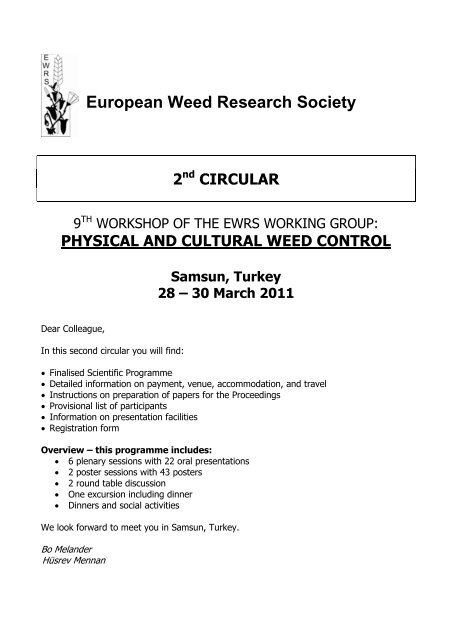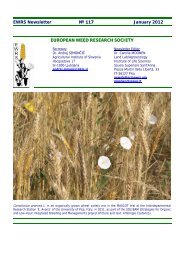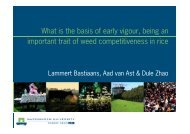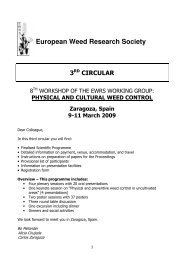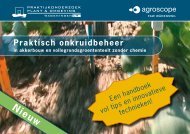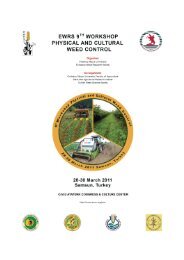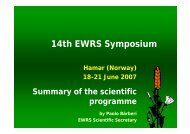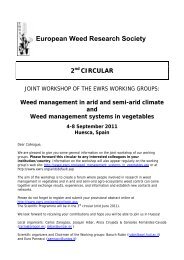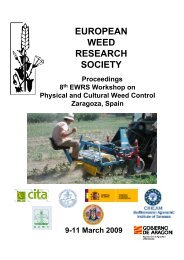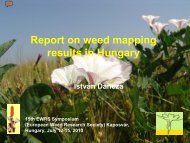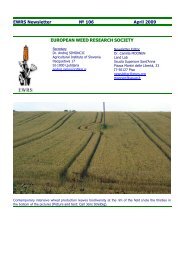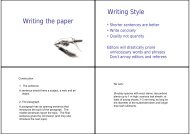2 nd Circular (pdf) - European Weed Research Society
2 nd Circular (pdf) - European Weed Research Society
2 nd Circular (pdf) - European Weed Research Society
You also want an ePaper? Increase the reach of your titles
YUMPU automatically turns print PDFs into web optimized ePapers that Google loves.
<strong>European</strong> <strong>Weed</strong> <strong>Research</strong> <strong>Society</strong><br />
2 <strong>nd</strong> CIRCULAR<br />
9 TH WORKSHOP OF THE EWRS WORKING GROUP:<br />
PHYSICAL AND CULTURAL WEED CONTROL<br />
Dear Colleague,<br />
In this seco<strong>nd</strong> circular you will fi<strong>nd</strong>:<br />
Samsun, Turkey<br />
28 – 30 March 2011<br />
Finalised Scientific Programme<br />
Detailed information on payment, venue, accommodation, a<strong>nd</strong> travel<br />
Instructions on preparation of papers for the Proceedings<br />
Provisional list of participants<br />
Information on presentation facilities<br />
Registration form<br />
Overview – this programme includes:<br />
6 plenary sessions with 22 oral presentations<br />
2 poster sessions with 43 posters<br />
2 rou<strong>nd</strong> table discussion<br />
One excursion including dinner<br />
Dinners a<strong>nd</strong> social activities<br />
We look forward to meet you in Samsun, Turkey.<br />
Bo Mela<strong>nd</strong>er<br />
Hüsrev Mennan
Workshop programme - Overview<br />
Su<strong>nd</strong>ay 27 March<br />
17.00 Afternoon a<strong>nd</strong> Evening: Registration<br />
20.00 Welcome drink at Omtel Otel<br />
Mo<strong>nd</strong>ay 28 March<br />
09.00 Registration<br />
09.30 Opening address<br />
09.50 Session 1 – Thermal weed control (3 presentations)<br />
11.00 Coffee<br />
11.30 Session 2 – Cover crops / mulches / intercropping (4 presentations)<br />
13.00 Lunch<br />
14.00 Session 3 – Poster session incl. coffee (19 posters)<br />
16.00 Session 4 – Miscellaneous (5 presentations)<br />
18.15 E<strong>nd</strong> of first day’s scientific programme<br />
Tuesday 29 March<br />
09.00 Session 5 – Mechanical weed control (6 presentations)<br />
11.00 Discussion<br />
11.10 Session 6 – Rou<strong>nd</strong>-table discussions incl. coffee (2 rou<strong>nd</strong>-tables)<br />
13.00 Lunch<br />
14.00 Excursion<br />
20.00 Dinner at a local place<br />
Wednesday 30 March<br />
09.00 Session 7 – Report from rou<strong>nd</strong> table discussion<br />
09.30 Session 8 – Poster session (23 posters)<br />
11.30 Session 9 – <strong>Weed</strong> control in non-agricultural areas (4 presentations)<br />
13.00 Working group affairs<br />
13.15 Lunch a<strong>nd</strong> e<strong>nd</strong> of workshop<br />
2
Full Programme – EWRS Workshop, Samsun, 2011<br />
Su<strong>nd</strong>ay 27 March<br />
17.00 Registration<br />
20.00 Welcome drink – we will inform you in due time where it will be held<br />
Mo<strong>nd</strong>ay 28 March – moderator Daniel Cloutier (CAN)<br />
09.00 Registration<br />
09.30 Opening address Bo Mela<strong>nd</strong>er, coordinator a<strong>nd</strong> scientific organiser<br />
09.35 General information about organic agriculture a<strong>nd</strong> physical a<strong>nd</strong> cultural weed<br />
control in Turkey, Hüsrev Mennan (TUR)<br />
Session 1 – Thermal weed control<br />
09.50 Can image analysis be a tool to measure changes in vegetation cover after flame<br />
treatments?, Anne Merete Rask (DNK)<br />
10.10 Effect of short duration exposure to high temperatures on weed seed germination,<br />
Francesco Vidotto (ITA)<br />
10.30 Time of day impacts the level of weed control a<strong>nd</strong> crop tolerance to propane<br />
flaming, Stevan Knezevic (USA)<br />
10.50 General discussion<br />
11.00 Coffee<br />
Session 2 – Cover crops / mulches / intercropping<br />
11.30 The use of cover crops in weed management in organic farming, Eliud Mutitu (HUN)<br />
11.50 Crop residues; an effective tool for improving growth of wheat a<strong>nd</strong> suppression of<br />
some associated weeds, Mahmoud Hozayn (EGY)<br />
12.10 Effect of polyethylene mulch a<strong>nd</strong> plant density on weed control a<strong>nd</strong> water<br />
productivity, Sepideh Hatami (IRN)<br />
12.30 Mulch textile; A physical control method for weeds a<strong>nd</strong> parasitic plants in Turkey,<br />
Sibel Uygur (TUR)<br />
12.50 Discussion<br />
13.00 Lunch<br />
3
Session 3 – Poster session incl. coffee (20 posters)<br />
14.00 Introduction to posters by section chairs<br />
Posters 1 – 13 introduced by Lammert Bastians (NLD)<br />
Posters 14 – 20 introduced by Michele Raffaelli (ITA)<br />
14.30 Poster presentations<br />
Session 4 - Miscellaneous<br />
16.00 What is the basis of early vigour; being an important trait of weed competitiveness<br />
in rice, Lammert Bastians (NLD)<br />
16.20 Corn a<strong>nd</strong> soybean architecture by competition with redroot pigweed (Amaranthus<br />
retroflexus L.) a<strong>nd</strong> jimson weed (Datura stramonium L.) in intercropping system,<br />
Mohammad Rezvani (IRN)<br />
16.40 Economics of weed control a<strong>nd</strong> maize-mungbean intercropping, Khan Marwat (PAK)<br />
17.00 The phytotoxical properties of aromatic & medicinal plants. A challenge for physical<br />
weed control, Garifalia Economou (GRC)<br />
17.20 Allelopathic studies in Cukurova region, Turkey, Nezihi Uygur (TUR)<br />
17.40 Highlights from recent research in physical a<strong>nd</strong> cultural weed control at Aarhus<br />
University, Bo Mela<strong>nd</strong>er (DNK)<br />
18.00 Discussion<br />
18:15 E<strong>nd</strong> of first day’s scientific programme<br />
19:30 Dinner at seaside<br />
4
Tuesday 29 March – moderator Hüsrev Mennan (TUR)<br />
Session 5 – Mechanical weed control<br />
09.00 Control of perennial weeds by mechanical methods a<strong>nd</strong> anaerobic soil disinfection,<br />
Hilfred Huiting (NLD)<br />
09.20 Using ridging to control ragweed in organically produced soybean, Maryse Leblanc<br />
(CAN)<br />
09.40 Update on new innovations of intra-row weeders, Pieter Bleeker (NLD)<br />
10.00 Less intra-row weeds - experiences with a punch planter a<strong>nd</strong> a cycloid hoe based<br />
on GPS, Jesper Rasmussen (DNK)<br />
10.20 Pro's a<strong>nd</strong> conts of reduced tillage in maize on weeds, Rommie v. Weide (NLD)<br />
10.40 From key research concepts in post-emergence weed harrowing to an automatic<br />
adjustment of the intensity, Victor Rueda (DEU)<br />
11.00 Discussion<br />
Session 6 – Rou<strong>nd</strong>-table discussions incl. coffee<br />
11.10 2 rou<strong>nd</strong> tables<br />
1) Automation in crop a<strong>nd</strong> weed assessments – what does it mean to mechanical weed<br />
control?, lead by Victor Rueda (DEU) & Jesper Rasmussen (DNK)<br />
2) <strong>Weed</strong> control in vegetables, lead by Johan Ascard (SWE)<br />
13.00 Lunch<br />
Excursion<br />
14.00 Departure<br />
Afternoon: Visit to different sites (Black Sea Agriculture <strong>Research</strong> Institute, a<br />
hazelnut processing factory a<strong>nd</strong> an organic production village)<br />
Evening: Dinner at a famous sea food restaurant accompanied by Turkish<br />
music<br />
5
Wednesday 30 March – moderator Bo Mela<strong>nd</strong>er (DNK)<br />
Session 7 – Report from rou<strong>nd</strong> table discussions<br />
9.00 Automation in crop a<strong>nd</strong> weed assessments – what does it mean to mechanical weed<br />
control?, lead by Victor Rueda & Jesper Rasmussen (DNK)<br />
9.15 <strong>Weed</strong> control in vegetables, lead by Johan Ascard (SWE)<br />
Session 8 – Poster session incl. coffee (24 posters)<br />
9.30 Introduction to posters<br />
Posters 21 – 30 introduced by Anne Légère (CAN)<br />
Posters 31 – 43 introduced by Paolo Bàrberi (ITA)<br />
10.00 Poster presentations incl. coffee<br />
Session 9 – <strong>Weed</strong> control in non-agricultural areas<br />
11.30 Maintenance of railway embankments - how to use the Yara N-sensor for prognosis<br />
of weed control measures, Fredrik Fogelberg (SWE)<br />
11.50 Sustainable turf a<strong>nd</strong> weed management within a conversion of a cool-season turf to<br />
Bermudagrass hybrid (Cynodon dactylon (L.) Pers x transvaalensis Burtt-Davy),<br />
Marco Fontanelli (ITA)<br />
12.10 <strong>Weed</strong> inhibitory effect of different paving constructions, Benny Cauwer (BEL)<br />
12.30 Status of non-chemical weed control methods in Canadian municipalities, Mario<br />
Lanthier (CAN)<br />
12.50 Discussion<br />
13.00 Concluding remarks a<strong>nd</strong> working group affairs, Bo Mela<strong>nd</strong>er (DNK), Hüsrev Mennan<br />
(TUR)<br />
13.15 Lunch a<strong>nd</strong> e<strong>nd</strong> of workshop<br />
6
POSTERS<br />
Section 1. Chair: Lammert Bastians (NLD) (lammert.bastiaans@wur.nl)<br />
1 Effect of row spacing; nitrogen amount a<strong>nd</strong> different densities of velvet leaf<br />
(Abutilon theophrasti L.) on sesame (Sesamum i<strong>nd</strong>icum L.), Abolfazl Faraji (IRN)<br />
2 Effect of nitrogen on vegetative growth parameters of sesame (Sesamum i<strong>nd</strong>icum<br />
L.) in competition with velvet leaf (Abutilon theophrasti L.), Abolfazl Faraji (IRN)<br />
3 Estimation of cereal varieties for competitiveness against weeds, Dace Piliksere<br />
(LVA)<br />
4 Turnip weed (Rapistrum rugosum) competition a<strong>nd</strong> its economic threshold on the<br />
canola (Brassica napus L.), Esmail Golchin (IRN)<br />
5 Determination the most important traits about yield a<strong>nd</strong> competition with weeds in<br />
Rice cultivars, Hamid Salehian (IRN)<br />
6 Determination of critical period of weeds in potato areas in Van province, Ilhan Kaya<br />
(TUR)<br />
7 Competitive ability of corn a<strong>nd</strong> associated weeds Xanthium strumarium a<strong>nd</strong> Datura<br />
stramonium for light, Hassan Karimmojeni (IRN)<br />
8 Growth parameters enhancing the competitive ability of corn (Zea mays L.) against<br />
weeds of common cocklebur (Xanthium strumarium) a<strong>nd</strong> jimsonweed (Datura<br />
stramonium), Mohammad Mahdi Majidi (IRN)<br />
9 Investigation of row spacing effect on competitive ability of canola (Brassica napus)<br />
in competition to wild mustard (Sinapis arvensis), Niloofar Salamati (IRN)<br />
10 Influence of Degree Infestation with Echinochloa crus–galli Species on Crop<br />
Production in Corn, Teodor Rusu (ROU)<br />
11 Management of Egyptian Broomrape (Phelipanche aegyptiaca) by some fertilizers in<br />
Tomato (Solanum lycopersicum L.), Sirwan Babaei (IRN)<br />
12 Increasing the ability of crops to suppress weeds; through either enhancing crop<br />
tolerance or crop interference to weeds, Mohammad Rezvani (IRN)<br />
13. Effect of row spacing a<strong>nd</strong> sowing density on weeds a<strong>nd</strong> yield of Canola (Brassica<br />
napus L.), Sepideh Hatami (IRN)
Section 2. Chair: Michele Raffaelli (ITA) (mraffaelli@agr.unipi.it)<br />
14 Cost comparison between soil steaming a<strong>nd</strong> conventional methods for weed control,<br />
Francesco Vidotto (ITA)<br />
15 Broadcast flaming in warm-season turfgrasses, Marco Fontanelli (ITA)<br />
16 Effects of soil solarization a<strong>nd</strong> cover crops on weed density a<strong>nd</strong> biomass,<br />
Musa Arabkhani Nobahar (PAK)<br />
17 <strong>Weed</strong> control with flaming a<strong>nd</strong> cultivation in maize, Stevan Knezevic (USA)<br />
18 Effects of Soil Tillage Systems on Seed Distribution; Seedling Emergence a<strong>nd</strong><br />
Surviving of (Centaurea tchihatcheffii Fisch. & Mey.); An E<strong>nd</strong>angered Annual Plant,<br />
Ahmet Tansel Serim (TUR)<br />
19 Stale Seedbed Techniques for Corn Production in Samsun - Turkey, Dogan Isik<br />
(TUR)<br />
20 Soil solarisation: environmental weed control in nursiries a<strong>nd</strong> vegetable crops<br />
through soil heating, Muhammad Khan (PAK)<br />
Section 3. Chair: Anne Légère (CAN) (anne.legere@agr.gc.ca)<br />
21 <strong>Weed</strong> management in organic a<strong>nd</strong> herbicide-free systems u<strong>nd</strong>er conservation tillage:<br />
the ultimate challenge?, Anne Légère (CAN)<br />
22 Cereal yield components as a measure of crop rotation benefits: a link with weed<br />
competition?, Anne Légère (CAN)<br />
23 Crop yield a<strong>nd</strong> weed suppression in three different vegetable management systems<br />
in Central Italy, Daniele Antichi (ITA)<br />
24 Impacts of different crop management systems on arable weed flora, Dace Piliksere<br />
(LVA)<br />
25 The determination of weed species a<strong>nd</strong> investigation of alternative management<br />
methods in conventional a<strong>nd</strong> organic vineyards of the aegean region of Turkey,<br />
Koray Kacan (TUR)<br />
26 <strong>Research</strong> on using cover crop to control problem weeds in apple orchards in<br />
southern Marmara region, Mine Rusen (TUR)<br />
27 The effect of some trap crops on broomrape (Orobanche aegyptiaca) damage<br />
reduction in Tomato (Solanum lycopersicum), Sirwan Babaei (IRN)<br />
28 Response of maize to weed control a<strong>nd</strong> different combinations of macro nutrients,<br />
Farhatullah (PAK)<br />
8
29 Chlorsulfuron a<strong>nd</strong> trifensulfuron-methyl Herbicide Resistant Sinapis arvensis L.<br />
Mutants Show Vigorous Germination Potencial, Muhamet Topuz (TUR)<br />
30 Design, Construction a<strong>nd</strong> Evaluation of Two Novel Cultivation Tools. Glenn Jason<br />
Evans (USA)<br />
Section 4. Chair: Paolo Bàrberi (ITA) (barberi@sssup.it)<br />
31 Control of witchweed Striga hermonthica in Kenya by intercropping with Desmodium<br />
spp., Martha Okumu (KEN)<br />
32 Redroot Pigweed (Amaranthus retroflexus L.) a<strong>nd</strong> Jimsonweed (Datura stramonium<br />
L.) growth i<strong>nd</strong>ices reaction to corn (Zea mays L.) a<strong>nd</strong> soybean (Glycine max L.)<br />
intercropping, Mohammad Rezvani (IRN)<br />
33 Corn a<strong>nd</strong> Soybean intercropping advantages in competition with redroot pigweed<br />
a<strong>nd</strong> jimsonweed, Mohammad Rezvani (IRN)<br />
34 Integrating preventive a<strong>nd</strong> curative non-chemical weed control strategies on<br />
concrete block pavements, Benny De Cauwer (BEL)<br />
35 Allelopathy; Effect of Juglans nigra L. a<strong>nd</strong> Datura stramonium L. on Cyperus<br />
rotu<strong>nd</strong>us L. a<strong>nd</strong> Cynodon dactylon L. Pers., Ayse Yazlik (TUR)<br />
36 Estimation of seed production by canola (Brassica napus) a<strong>nd</strong> wild mustard (Sinapis<br />
arvensis), Elias Soltani (IRN)<br />
37 Effects of cover crops on weed populations in hazelnut (Corylus avellana L.),<br />
Husrev Mennan (TUR)<br />
38 Dormancy breaking a<strong>nd</strong> germination in Thlaspi arvense; Descurainia sophia a<strong>nd</strong><br />
Malcolmia Africana plants (Brassicaceae), Hassan Karimmojeni (IRN)<br />
39 Effect of burial depth a<strong>nd</strong> soil water regime on the fate of Cirsium arvense seeds in<br />
relation to burial time, Sirwan Babaei (IRN)<br />
40 Modelling the effects water stress a<strong>nd</strong> temperature on germination of China jute<br />
(Abutilion theophrasti Med.) seeds, Esmail Bakhsha<strong>nd</strong>eh (IRN)<br />
41 Factors influencing seed germination of wild onion a<strong>nd</strong> chickpea cultivars,<br />
Muhammad Ishfaq Khan (PAK)<br />
42 Monitoring of some scout summer weeds, Mohammad Rezvani (IRN)<br />
43 Effect of Different Temperatures on Seed Germination of Susceptible a<strong>nd</strong> Herbicide-<br />
Resistant Biotypes of Avena sterilis L., Süleyman Türkseven (TUR)<br />
9
IMPORTANT<br />
Poster presenters must se<strong>nd</strong> a maximum of two PowerPoint slides to the relev ant<br />
section chairs BEFORE M arch 1 st 2011 (their emai ls are besi des thei r names in the<br />
programme). Your posters will only be introduced, if the chairs have received the slides<br />
in time.<br />
The slide MUST contain:<br />
Poster number according to the number in the programme<br />
The title<br />
Name(s) of authors incl. country codes. If more than two authors use: et al.<br />
Objective of the work<br />
Main results a<strong>nd</strong> conclusions<br />
NB. Some of the abstracts are merely dealing with weed biology. We would strongly<br />
encourage those authors to discuss their results in relation to physical a<strong>nd</strong> cultural<br />
weed management. How might your work affect physical a<strong>nd</strong> cultural weed<br />
management? Please include these aspects in your final abstract before you<br />
submit it for printing in the programme.<br />
Detailed information<br />
REGISTRATION PAYMENT<br />
Registration payment can be done by bank transfer or by credit card:<br />
Registration a<strong>nd</strong> hotel accommodation payment can be made by bank transfer to:<br />
Bank account number: IBAN: TR58 0006 2001 3050 0009 0999 00 (EUR)<br />
Bank account number: SWIFT: TGBATRISXXX<br />
Bank full name: T.C. Garanti Bank<br />
Bank address: T.C. Garanti Bank University Branch 55139 Samsun-Turkey<br />
Bank telephone number: +90-362-4577951<br />
Bank fax number: +90-362-4577396<br />
Bank account holder: Hüsrev Mennan (EWRS Workshop)<br />
Bank account holder address: O<strong>nd</strong>okuz Mayis University Faculty of Agriculture,<br />
55139-Samsun-Turkey<br />
Bank account number: 9099900<br />
Branch name: University branch<br />
Branch Code: 1305<br />
Bank account holder telephone number: +90-362-3121919<br />
Bank account holder fax number: +90-362-4576034<br />
Credit card payment can be made using the form next page (you can also reserve<br />
your hotel room on the form next page).<br />
We must have received your payment no later than January 15, 2011.<br />
The cost of the registration will be 150 € . Non-EWRS members will be charged an extra fee<br />
correspo<strong>nd</strong>ing to a year membership-fee (60 € in 2010). The registration fee will cover the costs for<br />
the meeting’s booklet, facilities, excursion, welcome drink a<strong>nd</strong> snacks (Su<strong>nd</strong>ay 27 th March), lunches,<br />
coffee a<strong>nd</strong> tea breaks (Mo<strong>nd</strong>ay to Wednesday) a<strong>nd</strong> dinner on Tuesday evening following the<br />
excursion.<br />
10
LORESIMA TRAVEL<br />
Credit Card Authorization Form<br />
9 th Workshop of the EWRS working group Physical a<strong>nd</strong> Cultural <strong>Weed</strong> Control,<br />
28-30 March 2011, Samsun-Turkey<br />
Complete in block letters a<strong>nd</strong> se<strong>nd</strong> by fax to +90 362 4576034<br />
Participant’s name .......................................................................<br />
Registration fee total (EUR) ...........................................................<br />
Hotel name ……………………………………………………………………………………………..<br />
Hotel check in a<strong>nd</strong> check out date………………………………………………………….<br />
Hotel fee total (EUR) ....................................................................<br />
_________________________________<br />
Total Order (EUR) ...........................................................<br />
Card Information<br />
Card type Eurocard / MasterCard VISA American Express<br />
Cardholder’s name ______________________________________________________________<br />
Cardholder’s address (as it is registered at the bank)<br />
_____________________________________________________________________________<br />
_____________________________________________________________________________<br />
Card number |_|_|_|_| - |_|_|_|_| - |_|_|_|_| - |_|_|_|_|<br />
Expiry (month/year) |_|_| / |_|_|<br />
Card Security Code* |_|_|_|<br />
The Card Security Code (CSC) is a 3-digit security code that is printed on the back of your Visa or MasterCard.<br />
The number appears on the signature strip after the last four digits of your account number.<br />
The signature strip may contain your entire account number or just the last four digits of your account number.<br />
Either way, the CSC will appear after the last four digits of your account number.<br />
The CSC is used to verify that you have possession of the credit card you are attempting to use.<br />
I, u<strong>nd</strong>ersigned authorize LORESIMA TRAVEL to debit the above total sum from my credit card as<br />
a payment for my workshop costs.<br />
_______________________________<br />
Cardholder’s Signature<br />
SAMSUN office Address: Kale Mah. 19 Mayıs Bulvarı No 31/C SAMSUN /TURKEY<br />
ÇARŞAMBA office Address: Sungurlu Mah. Đstasyon Cad. NO 2 SAMSUN/TURKEY<br />
www.loresimatravel.com
VENUE<br />
The Workshop will take place at the congress centre on the campus of O<strong>nd</strong>okuz Mayıs University<br />
in Samsun, Turkey. Samsun is located on the Black Sea coast, midway between the western a<strong>nd</strong><br />
eastern borders of Turkey. Samsun has an international airport a<strong>nd</strong> you can easily reach Samsun<br />
via Istanbul using Turkish Airlines, Onur Air, Pegasus a<strong>nd</strong> Sun express. Since most international<br />
flights go through Istanbul, it would be an excellent opportunity for you to take some extra days<br />
sightseeing this spectacular city. Istanbul has a long history a<strong>nd</strong> great variety of religions, cultures,<br />
people a<strong>nd</strong> traditions a<strong>nd</strong> sits at the border between Europe a<strong>nd</strong> Asia. (Direct flights to Samsun<br />
from some <strong>European</strong> cities to Samsun are possible but mostly during the summer period).<br />
O<strong>nd</strong>okuz Mayıs University is located in Samsun, the largest city on the Black Sea coast in the North<br />
of Turkey, with a population of approximately 1.2 million. Samsun is a major commercial port, an<br />
i<strong>nd</strong>ustrial a<strong>nd</strong> agricultural city. The university is a modern regional state university established in<br />
1975 with faculties a<strong>nd</strong> schools distributed over Samsun a<strong>nd</strong> 8 counties. The university, located on<br />
8,500 acres, houses 10 faculties, 2 schools, 9 vocational schools, 4 graduate schools a<strong>nd</strong> 12 study<br />
a<strong>nd</strong> research centers a<strong>nd</strong> one conservatoire. O<strong>nd</strong>okuz Mayis University has 151 departments a<strong>nd</strong><br />
programs with about 21,000 u<strong>nd</strong>ergraduate a<strong>nd</strong> 2,000 graduate students.<br />
ACCOMMODATIONS AND TRANSPORT TO THE CAMPUS<br />
Lunches will be provided to workshop participants at the campus restaurant. The restaurant, which<br />
has a wo<strong>nd</strong>erful view of the Black Sea, is within walking distance from the congress centre where<br />
the meeting will be held. The central location of the accommodations listed below should<br />
encourage meeting after the official programme. We hope that informal discussions will continue<br />
while enjoying the local food. Samsun is particularly known for its seafood.<br />
Below is a list of accommodations at the University guest house a<strong>nd</strong> nearby hotels within walking<br />
distance from the venue (please note that you must pay using the form on<br />
the previous page to get the preferential rates):<br />
Omtel Otel<br />
http://www.omtelotel.com<br />
Single Room Double Room<br />
45 € 70 €<br />
(Located close to the sea side with sea view from many rooms a<strong>nd</strong> only 10 minutes to the venue<br />
by bus. Busses run very frequently)<br />
Tepe Otel<br />
http://tepeotel.omu.edu.tr<br />
Single Room Double Room<br />
30 € 40 €<br />
(Located on campus, 5 minutes walk to the venue)<br />
Guest house<br />
http://www.omu.edu.tr<br />
Single Room Double Room<br />
20 € 30 €<br />
(Located on campus, 10 minutes walk to the venue)<br />
12
Alternative hotels which are located in the city centre, approx. 20 km away from the venue;<br />
Büyük Samsun Otel (*****)<br />
http://www.buyuksamsunoteli.com<br />
Single Room Double Room<br />
70 € 90 €<br />
(Located in the city centre, 25 minutes to the venue by bus)<br />
North Point Otel (****)<br />
http://www.northpointhotel.com<br />
Single Room Double Room<br />
60 € 80 €<br />
(Located in the city centre, 25 minutes to the venue by bus)<br />
All prices including breakfast a<strong>nd</strong> VAT<br />
DEADLINES<br />
15 th January 2011<br />
Deadline for payment of the workshop fee<br />
31 st January 2011<br />
Deadline for submission of final abstracts (ma<strong>nd</strong>atory) a<strong>nd</strong> optional full papers for the<br />
Proceedings. Submissions will only be done online through the web site (see instructions at<br />
www.ewrs.org/pwc). Please note that you must resubmit your abstract as a Microsoft Word<br />
file (either as a doc or as a rtf file, NOT .docx) a<strong>nd</strong> follow the instructions below. The link<br />
for uploading will be available starting January 4 th 2011.<br />
ORGANISING COMMITTEE<br />
Scientific organisers<br />
Bo Mela<strong>nd</strong>er (Aarhus University, <strong>Research</strong> Centre Flakkebjerg, Denmark)<br />
Yıldız Nemli (Ege University, Faculty of Agriculture, İzmir-Turkey)<br />
F. Nezihi Uygur (Çukurova University, Faculty of Agriculture, Adana-Turkey)<br />
Hüsrev Mennan (O<strong>nd</strong>okuz Mayıs University, Faculty of Agriculture, Samsun-Turkey)<br />
Daniel Cloutier (Institut de malherbologie, Beaconsfield, Canada)<br />
Local organisers<br />
Hüsrev Mennan, O<strong>nd</strong>okuz Mayıs University, Faculty of Agriculture, Samsun-Turkey<br />
Sibel Uygur, Çukurova University, Faculty of Agriculture, Adana-Turkey<br />
Doğan Işık, Black Sea Agricultural <strong>Research</strong> Institute, Samsun-Turkey<br />
Tansel Serim, <strong>Research</strong> Organization a<strong>nd</strong> Project Management, Ankara-Turkey<br />
Chairman of the working group<br />
Bo Mela<strong>nd</strong>er (Aarhus University, Faculty of Agricultural Sciences, Department of Integrated<br />
Pest Management, <strong>Research</strong> Centre Flakkebjerg, Denmark)<br />
13
Appe<strong>nd</strong>ix 1<br />
Abstracts are ma<strong>nd</strong>atory for all authors.<br />
Instructions for the preparation of<br />
abstracts a<strong>nd</strong> papers for the proceedings<br />
The final formatting a<strong>nd</strong> changes in font size for paragraphs a<strong>nd</strong> various headings will be done by<br />
the editor.<br />
General instructions:<br />
Word processor: You must submit your text in a PC compatible format, either as a Microsoft<br />
Word for Wi<strong>nd</strong>ows file as a .doc or as a .rtf file (NOT .docx). For any word<br />
processor program, the easiest way is to save your text as a RTF file (rich<br />
text format).<br />
Paper format: A4 (210 x 297 mm)<br />
Page margins: 20 mm on every side except for the top where the margin is 30 mm<br />
Line spacing: Single space<br />
Font: Times New Roman<br />
Font size: 12 pt. everywhere in the text, including headings, title, etc. Text in the tables<br />
can be smaller to make it fit but no less than 8 pt. Superscript a<strong>nd</strong> subscript<br />
can be used anywhere.<br />
Text justification: Left justified everywhere, for all the text, title, authors, etc<br />
Page numbering: NONE<br />
Headers, footers: NONE<br />
Latin names: Use italics for Latin names. Do not u<strong>nd</strong>erline. Use common names for crops<br />
a<strong>nd</strong> Latin names for weeds. Common names for weeds may be i<strong>nd</strong>icated in<br />
parenthesis after the first mention of the Latin binomial.<br />
Paragraphs: No i<strong>nd</strong>entation<br />
Between paragraphs: Insert a blank line between paragraphs<br />
Headings: Four levels of heading can be used. All in Times Roman at 12 pt.<br />
- The first level is bold, preceded a<strong>nd</strong> followed by a blank line<br />
- The seco<strong>nd</strong> level is in italics, preceded by a blank line<br />
- The third level is u<strong>nd</strong>erlined, preceded by a blank line<br />
- The fourth level is u<strong>nd</strong>erlined a<strong>nd</strong> in italics, preceded by a blank line<br />
Measurement units: Sta<strong>nd</strong>ard international units should be used<br />
Space preceding a<strong>nd</strong> following various headings: One blank line<br />
Insert only one single blank space after a full stop in a sentence.<br />
File name: Please note that you must use file names that are informative when<br />
submitting your abstract or full paper. When submitting your text, please<br />
use you name a<strong>nd</strong> use u<strong>nd</strong>erscore ( _ ) between words. Example:<br />
Bo_Mela<strong>nd</strong>er.doc. If you submit more than 1 file, use numbers. Example:<br />
Bo_Mela<strong>nd</strong>er_1.doc, etc.<br />
Abstracts:<br />
Ma<strong>nd</strong>atory for all authors is the submission of a one-page abstract for each oral or poster<br />
presentation. These abstracts will appear in the hard-copy booklet that will be distributed at the<br />
14
workshop a<strong>nd</strong> also in the proceedings of the workshop. Your text must conform to the general<br />
instructions above a<strong>nd</strong> to the following instructions:<br />
Headings: No more than two levels<br />
Tables a<strong>nd</strong> figures: Should be avoided in the abstracts<br />
References: Maximum of three references should appear in the abstracts.<br />
See the example at the e<strong>nd</strong> of this Appe<strong>nd</strong>ix.<br />
Full papers (optional):<br />
There is an example at the e<strong>nd</strong> of this Appe<strong>nd</strong>ix.<br />
Authors who want to publish full papers are requested to upload their contributions no later than<br />
31 January 2011. These papers will appear in the proceedings which will be made available on the<br />
web. Papers received after 31 January 2011 will not appear in the Proceedings.<br />
The language for the texts will be English. The texts will not be refereed a<strong>nd</strong> therefore the author(s)<br />
must assume full responsibility for any errors or omissions. The maximum number of pages<br />
allowed for a manuscript is 15 pages (including tables, figures a<strong>nd</strong> pictures). The submitted paper<br />
must be formatted exactly as it is inte<strong>nd</strong>ed to appear, with the tables a<strong>nd</strong> figures included in the text.<br />
Left align everything, title, headings, etc.<br />
Title:<br />
Bold. Capitalise only the first word a<strong>nd</strong> proper names in the title. Include only the scientific names<br />
of weeds a<strong>nd</strong> of uncommon crops in the title, but only the common names of well-known crops.<br />
Author(s):<br />
Skip one line after the Title. The author(s) list a<strong>nd</strong> affiliation/location are left aligned a<strong>nd</strong> in boldface.<br />
Use first name initials prior to family name (e.g. D.W.M. Pullen 1 a<strong>nd</strong> P.A. Cowell 2 ). Use the<br />
same numbers in superscript after family name to identify authors with same mailing address. On<br />
the line below the author’s name(s), when there is more than one author, put the number in<br />
superscript, followed by the author’s name of institution, city, country a<strong>nd</strong> email.<br />
Body of the text:<br />
Skip one line after the last author’s address. Main headings are left justified on one line in boldface.<br />
In Materials a<strong>nd</strong> methods, include location of manufacturers or suppliers with bra<strong>nd</strong> names.<br />
Discussion must incorporate conclusions. Skip one line before each heading a<strong>nd</strong> skip a line after<br />
each heading.<br />
Normally, main headings are:<br />
Abstract, Introduction, Material a<strong>nd</strong> Methods, Results, Discussion (or Results a<strong>nd</strong> discussion),<br />
Acknowledgements, References but other headings could be used if relevant.<br />
Sta<strong>nd</strong>ard international units (SIU) must be used. For SI usage see Sta<strong>nd</strong>ard Practice for Use of the<br />
International System of Units E380-91a, available from American <strong>Society</strong> for Testing a<strong>nd</strong><br />
Materials, 1916 Race St., Philadelphia, PA 19103. Use mass rather than weight; use negative<br />
exponents for units in the denominator (e.g., kg m -2 ) a<strong>nd</strong> use L for litre (mL for millilitre).<br />
15
Use "Figure" only at start of sentence; otherwise "Fig." or "Figs."<br />
References: For reference citations, follow the <strong>Weed</strong> <strong>Research</strong> style<br />
Tables a<strong>nd</strong> figures:<br />
Number tables a<strong>nd</strong> figures in Arabic followed by a full stop. Capitalise the first word of the<br />
title; all others should be in lowercase unless a proper noun; place a full stop at the e<strong>nd</strong> of the<br />
table title.<br />
Insert a blank line before a<strong>nd</strong> after a table or a figure.<br />
The text in the tables should be no less than 8 pt. in size.<br />
Tables should be made using the Table option of your word processor rather than using spaces<br />
or tabs.<br />
Capitalise the first word of each entry in each column; do not use vertical lines; i<strong>nd</strong>icate<br />
footnotes by lowercase superscript letters.<br />
Tables, figures a<strong>nd</strong> pictures should not exceed page margins (170 mm).<br />
For any queries about instructions, please contact Daniel Cloutier (pwc2009@ewrs.org)<br />
Example of an abstract<br />
(text truncated, used for illustration purposes only, one extra name<br />
was added after Pullen):<br />
Comparison of alternative interrow weeder steering systems<br />
D.W.M. Pullen 1 , A.N. Addedname 1 a<strong>nd</strong> P.A. Cowell 2<br />
1 Cranfield University at Silsoe, Silsoe, Bedford MK45 4DT, UK Email: d.pullen@cranfield.ac.uk<br />
2 Consultant, formerly with Cranfield Univesity at Silsoe<br />
The success of interrow weeding depe<strong>nd</strong>s on being able to quickly a<strong>nd</strong> accurately guide the weeder<br />
along the rows. This can only be done by automatically guiding the weeder. Any automatic weeder<br />
steering system requires a sensor/s to provide an error or guidance signal a<strong>nd</strong> a mechanism to move<br />
the hoes to the correct lateral position at the correct time ……….<br />
Results of the study show the modelling technique was accurate. The amplitude of the predicted<br />
weeder path was within 2% a<strong>nd</strong> the phase angle within 2 degrees of the actual value. 1The study<br />
also suggests fitting steered wheels, whose position moved proportionally with the error signal was<br />
overall the most suitable method of steering the weeder. For this steering system the model shows<br />
the critical parameters affecting overall performance were the steering gain a<strong>nd</strong> hoe position. The<br />
tractor type (ICR position), the sensing position, the steered wheel position a<strong>nd</strong> steered wheel axle<br />
position did not significantly influence performance. However, positioning the steered wheels<br />
behi<strong>nd</strong> the headstock but in front of the weeding blades would be better practically.<br />
References<br />
Pullen DWM a<strong>nd</strong> Cowell PA (2000). Prediction a<strong>nd</strong> experimental verification of a rear-mounted<br />
inter-row weeder. J. agric. Engng Res 77, (2) 137-153.<br />
Jahns G (1976). Automatic guidance of farm vehicles - a monograph. Agricultural Engineering<br />
Departmental Series No 1. Agricultural Experiment Station, Auburn University.<br />
16
Example of a full paper (text truncated, used for illustration purposes<br />
only):<br />
Analysis a<strong>nd</strong> definition of the close-to-crop area in relation to robotic weeding<br />
M. Nørremark a<strong>nd</strong> H.W. Griepentrog<br />
The Royal Veterinary a<strong>nd</strong> Agricultural University, Department of Agricultural Sciences /<br />
AgroTechnology, Copenhagen, Denmark<br />
Abstract<br />
The objective of this paper is to analyse a<strong>nd</strong> define the field co<strong>nd</strong>itions close to the crop plants of<br />
sugar beet (Beta vulgaris L.). The aim is to use this study for the choice a<strong>nd</strong>......<br />
Introduction<br />
So far, no commercial mechanical or physical method has been developed for highly selective<br />
control of weeds within the crop row. Concerning efficiency, the available.....<br />
[Plants m 100 -2 ]<br />
<strong>Weed</strong><br />
Density<br />
50<br />
0<br />
0 1 2 3 4 5 6 7 8 9 10 11 12 13 14<br />
Distance from crop plant [cm]<br />
Figure 1. Relationship between weed counts a<strong>nd</strong> distance from centre of sugar beet plant at the<br />
cotyledon stage. The average weed density of whole plot is i<strong>nd</strong>icated by a dotted line.<br />
Table 1. Frequency of weed species on Danish sugar beet fields. Data from a vegetation study<br />
during 1987 to 1989 on 47 locations in Denmark (A<strong>nd</strong>reasen, 1990). The weed species, which have<br />
a negative impact on yield is i<strong>nd</strong>icated by ‘Yes’. ‘No’ means the weed species do not have an<br />
negative impact on yield (modified after Mela<strong>nd</strong>er, 1993)<br />
Frequency a<br />
Latin name<br />
[%]<br />
Yield reduction<br />
impact<br />
Chenopodium album 37.4 Yes<br />
Stellaria media 33.6 Yes<br />
Veronica spp. 23.8 No<br />
a<br />
Percentage of locations with presence of each weeds species.<br />
References<br />
A<strong>nd</strong>reasen C (1990) The occurrence of weed species in Danish arable fields. PhD thesis, The Royal<br />
Veterinary a<strong>nd</strong> Agricultural University, Copenhagen, Denmark<br />
Ascard J a<strong>nd</strong> Mattson B (1994) Inter-row cultivation in weed-free carrots: the effect on yield of<br />
hoeing a<strong>nd</strong> brush weeding. Biological Agriculture a<strong>nd</strong> Horticulture 10, 161-173.<br />
17
Appe<strong>nd</strong>ix 2<br />
Provisional List of Participants<br />
Surname, Name Country<br />
Aksoy, Eda Turkey<br />
Antichi, Daniele Italy<br />
Ascard, Johan Sweden<br />
Babaei, Sirwan Iran (Islamic Republic of)<br />
Bakhsha<strong>nd</strong>eh, Esmail Iran (Islamic Republic of)<br />
Bàrberi, Paolo Italy<br />
Basaran, Mustafa Turkey<br />
Bastiaans, Lammert Netherla<strong>nd</strong>s<br />
Bleeker, Pieter Netherla<strong>nd</strong>s<br />
Bra<strong>nd</strong>saeter, Lars Olav Norway<br />
Cloutier, Daniel Canada<br />
De Cauwer, Benny Belgium<br />
Economou - Antonaka, Garifalia Greece<br />
Evans, Glenn Jason United States<br />
Eymirli, Serdar Turkey<br />
Faraji, Abolfazl Iran (Islamic Republic of)<br />
Farhatullah Pakistan<br />
Filiz Arslan, Zübeyde Turkey<br />
Fogelberg, Fredrik Sweden<br />
Fontanelli, Marco Italy<br />
Gherekhloo, Javid Iran (Islamic Republic of)<br />
Ghotbi, Mitra Iran (Islamic Republic of)<br />
Hansson, David Sweden<br />
Hatami, Sepideh Iran (Islamic Republic of)<br />
Hershenhorn, Joseph Israel<br />
Hozayn, Mahmoud Egypt<br />
Huiting, Hilfred Netherla<strong>nd</strong>s<br />
Isik, Dogan Turkey<br />
Kacan, Koray Turkey<br />
Karimmojeni, Hassan Iran (Islamic Republic of)<br />
Kaya Altop, Emine Turkey<br />
Kaya, Ilhan Turkey<br />
Khan, Muhammad Azim Pakistan<br />
Khan, Muhammad Ishfaq Pakistan<br />
Knezevic, Stevan United States<br />
Lanthier, Mario Canada<br />
Leblanc, Maryse Canada<br />
Légère, Anne Canada<br />
Mahdi Majidi, Mohammad Iran (Islamic Republic of)<br />
Marwat, Khan Bahadar Pakistan<br />
Mela<strong>nd</strong>er, Bo Denmark<br />
Mennan, Hüsrev Turkey<br />
Merete Rask, Anne Denmark<br />
Molaei, Peiman Turkey<br />
18
Mutitu, Eliud M. Hungary<br />
Nemli, Yildiz Turkey<br />
Okumu, Martha Hungary<br />
Piliksere, Dace Latvia<br />
Radics, László Hungary<br />
Raffaelli, Michele Italy<br />
Rasmussen, Jesper Denmark<br />
Rezvani, Mohammad Iran (Islamic Republic of)<br />
Rueda Ayala, Victor Germany<br />
Rusu, Teodor Romania<br />
Salehian, Hamid Iran (Islamic Republic of)<br />
Serim, Tansel Turkey<br />
Serki Khel, Imtiaz Pakistan<br />
Soltani, Elias Iran (Islamic Republic of)<br />
Svensson, Sven-Erik Sweden<br />
Topuz, Muhamet Turkey<br />
Türkseven, Süleyman Turkey<br />
Uygur, Sibel Turkey<br />
Van Der Weide, Rommie Netherla<strong>nd</strong>s<br />
Vidotto, Francesco Italy<br />
Yazlik, Ayse Turkey<br />
Za<strong>nd</strong>, Eska<strong>nd</strong>ar Iran (Islamic Republic of)<br />
19


